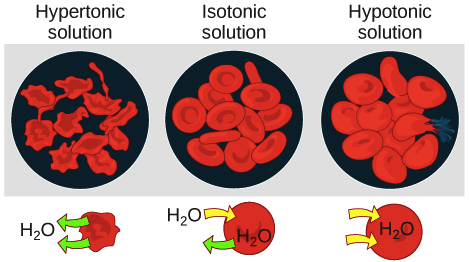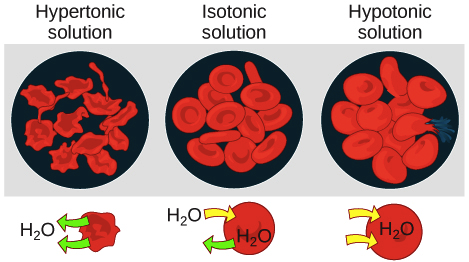2.4 Active Transport, Simple Diffusion & Osmosis, Facilitated Diffusion, Endocytosis, Exocytosis, and Receptor Mediated Transport
1/24
Earn XP
Name | Mastery | Learn | Test | Matching | Spaced |
|---|
No study sessions yet.
25 Terms
What is passive transport?
The transport of molecules through the use of the concentration gradient (from high conc. → low)
DOES NOT NEED ENERGY
What is active transport?
The transport of molecules against the concentration gradient (now from low conc. → high) by USING ENERGY (usually ATP)
Primary/Direct Active Transport
Move positive ions across the cell membrane, using energy to go against the concentration gradient
Primary Transport: Sodium-Potassium Pump
Pump Na+ ions OUT of the cell, K+ ions INTO the cell
Pump faces inside cell, has high affinity for Na+ ions → binds to 3
ATP also binds to pump, phosphate group breaks off and attaches separately, leaves ADP as byproduct
Binding to phosphate group tiggers pump to face outwards, loses affinity for Na+ ions → dumps 3 outside of cell
High affinity for K+ ions → binds to 2, no longer attracted to phosphate group → breaks off
Losing phosphate group triggers pump to face inwards, loses affinity for K+ ions → dumps 2 inside cytoplasm
Back to step 1
Secondary Active Transport
Energy source derives from primary pump’s concentration gradient
Symport: Transported solute moves in same direction as driving solute
Eg. Sodium (driving) & Glucose
Glucose goes against its gradient to follow sodium
Antiport: Transported solute moves in opposite direction as driving solute
Eg. Sodium (driving) & Calcium
Calcium goes against its gradient to go in opposite direction as sodium
Active Transport Example: Soil → Root Hairs
Low solute conc. in soil, high ion conc. in root hairs
Stored energy moves minerals into root hairs (against conc. gradient) for the plant to absorb
3 Things That Happen if Active Transport Malfunctions
Accumulate Waste Products
Disrupt Fluid Balance
Typically, active transport maintains fluid between cells + body compartments
Without = dehydration
Less/More Nutrient Intake
Without active transport bringing nutrients into the cell, less energy = impaired function
What is simple diffusion?
Moving molecules across the cell membrane without energy — following the concentration gradient
Hydrophobic: enters lipid bilayr
Hydrophilic: bounces back
What is osmosis?
The passive diffusion of water through the cell membrane
Solute Concentration vs Water Potential
HIGH SOLUTE CONC. = LOW WATER POTENTIAL
LOW SOLUTE CONC. = HIGH WATER POTENTIAL
water will go where there’s a higher solute conc.
What happens when a cell is placed in a hypotonic solution?
LOW SOLUTE CONC. OUTSIDE vs inside the cell
WATER MOVES IN → causes cell to swell, potentially burst

What happens when a cell is placed in a hypertonic solution?
HIGH SOLUTE CONC. OUTSIDE vs inside the cell
WATER MOVES OUT → causes cell to shrivel

What happens when a cell is placed in an isotonic solution?
SAME SOLUTE CONC. IN & OUT
Nothing happens
What does hyposmotic mean?
The cell OR solution has a LOWER solute concentration
What does hyperosmotic mean?
The cell OR solution has a HIGHER solute concentration
What does isosmotic mean?
The cell and solution have the same solute concentration
What is facilitated diffusion?
The transport of ions and polar molecules across the cell membrane via proteins
Still follows concentration gradient
Also dependent on transport protein efficiency
No energy required!
Rate of Diffusion: Simple Diffusion vs. Facilitated Diffusion
Simple diffusion: As conc. diff. increases, rate of diffusion increases at a constant rate
Facilitated diffusion: As conc. diff. increases, rate of diffusion increase a lot UNTIL a max. amount (when there’s not enough proteins per molecule)
Facilitated Diffusion: Channel Proteins
Channels solutes across membrane
Much faster than carrier proteins!
Eg. Malfunction = Cystic Fibrosis
CFTR channel can’t open
Water remains inside cells
Sticky mucus lining
Facilitated Diffusion: Carrier Proteins
Binds to molecule to be carried across membrane (that’s why slower than channel proteins)
Specific to solute (similar to enzymes)
Carrier proteins open towards high solute conc.
Solute binds to protein!
Triggers protein to open towards low solute conc.
Solute released, protein reverts to step 1
What is exocytosis and endocytosis?
Process that allow eukaryotes to transport large molecules
Both REQUIRE ENERGY
Exocytosis: Export materials from cytosol → cell exterior
Endocytosis: Import materials from cell exterior → engulf inside cytosol
Cytosol: Fluid portion of cytoplasm
How does exocytosis work? Examples?
Vesicles within cytoplasm release materials into plasma
Eg. Enzymes + mucus secreted by cells lining digestive tracts
How does endocytosis work?
Cell membrane surrounds substance outside membrane
Pocket pinched off to form: endocytic vesicle
What are the steps for receptor mediated endocytosis?
Molecules outside of cell bind to specific receptor proteins on cell’s surface
Gather in a pit coated in clathrin proteins
Coated pit forms vesicle, separates from membrane
Vesicle loses protein coating → fuses with lysosome
Digested by enzymes
Receptor Mediated Endocytosis Malfunction: Cholesterol Example
RME removes “bad cholesterol” (low-density lipoproteins) from blood
Hypercholesterolemia: Missing LDL receptors = failure to remove LDL = dangerous levels in blood